This stirring Top End festival is among the world’s greatest
By Anabel Dean
Camp is a sacred place: an escarpment that curls like the spine of a crocodile along the Gulf of Carpentaria in the Northern Territory.
It is the primordial ceremonial site of the Yolngu Yolngu people where a traditional welcome begins with feet dancing in the skin of the Earth and a shifting tide of bodies pulsating to the rhythmic beat of the clapsticks. Red flag-wielding Dilak elders, men and women of all ages draped in cloth and pelt, branded t-shirts and caps, stomp into dust clouds between gyrating children.
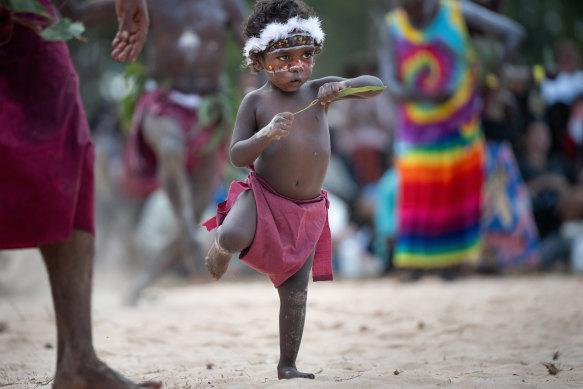
Dancers of all ages stomp into dust clouds.Credit: Nina Franova
This free-wheeling frenzy of colour and movement is not just entertainment. The Garma Festival is a curated invitation to the clans to join in the diplomacy of kinship, the continuation of story, a form of literature linked by song and design as accurate as the GPS co-ordinate of a forest or a beach in a sacred location.
Travellers who come as outsiders and enthusiasts to experience the largest Indigenous celebration of art, politics and life in Australia will not find it bundled easily into a glossy travel brochure. This is a gift to be unwrapped slowly. Slow like the snaking line for food served from bain-maries and the queue for the cold-water showers. Loud like the bands that play until 11pm and the generators that snarl through the dark hours. And basic, like the accommodation in canvas tents packed, sardine style, at the edge of the ceremonial grounds.
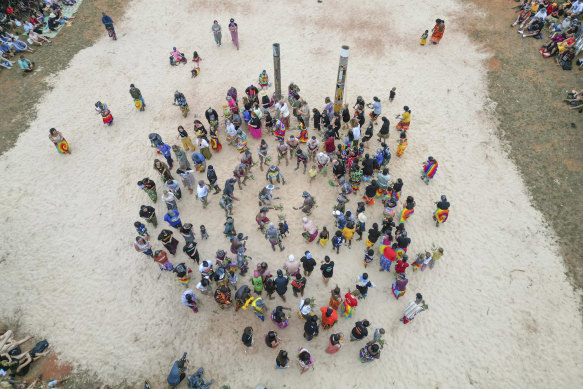
A frenzy of colour and movement … Garma Festival.Credit: Peter Eve
And yet, it’s a rare privilege, a permit granted to engage unfettered over four days with the oldest living culture on Earth.
The country of the Gumatj clan of the Yolngu nation is about 40 kilometres from the town of Nhulunbuy in remote North-East Arnhem Land. One of the great strongholds of traditional culture, it’s a dot in the vast tract of Aboriginal land that measures almost 100,000 kilometres across the Gove Peninsula.
The Yolngu welcome all visitors with open arms. Last year, in the dry-season stillness of morning, a celebration of life was set in motion with a spiritual healer calling ancestors and people together to the sound of a didgeridoo (yidaki). A white fella was seated in a camp chair under the stringy bark trees, head bowed and eyes closed, body swaying with the yidaki as it traced a skin line upwards to his heart in a sacred therapy rooted into ground as old as time. Vibrations started in a low drone as timbre intensified, spiralled and swelled, gathered power, then stopped. Men of two colours embraced. One sound. One language. One healing.
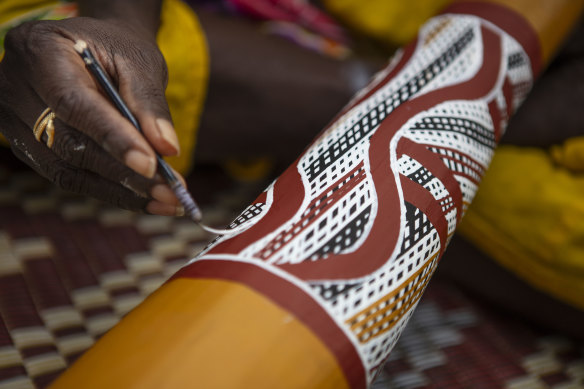
The sacred sounds of the didgeridoo (yidaki) calls to ancestors.Credit: Melanie Faith Dove
“It’s the equivalent of an MRI scan,” said an onlooker at the edge of a group.
Reconciliation has always been achieved through access, relationships and trust, and an amicable exchange along these lines has been in existence for the Yolngu for thousands of years. Call it tourism, or trade, it’s always been this way with other clans and with the Maccassan fishermen of Sulawesi in Indonesia who started dealing for highly valued jelly-like sea cucumber or trepang in the 1600s.
Last year, more than 5000 people came to the event, ranked with Diwali in India and the Day of the Dead in Mexico as one of the world’s top festivals. This year, the theme of the festival will be “Worrk”, a Yolngu word that means “cleansing country for new growth″. Some Aboriginal leaders will speak for the first time since the Indigenous Voice to Parliament referendum, resuming spirited discussions as white fellas (balanda) and First Nations People come together to engage in two-way learning. Understanding.
The great Yolngu elder and festival co-founder, Mandawuy Yunupingu, died in 2013. Yunupingu was born into a world governed by seasons, kinship, fellowship and duty. His allegiance was to the song-cycles, the ancestors, the law of the land, and his legacy remains resilient at the festival that began more or less as a backyard barbecue, in 1999, and now leads national discussion on issues of importance to all Australians.
At the rim of the escarpment, in the Garrtjambal Auditorium, senior Indigenous thinkers will sit shoulder to shoulder with non-Indigenous policy-makers. Pressing issues around the reprehensible gulf between white and black life expectancy and education and justice, these are topics of continued debate, but always with respect for differences of opinion.
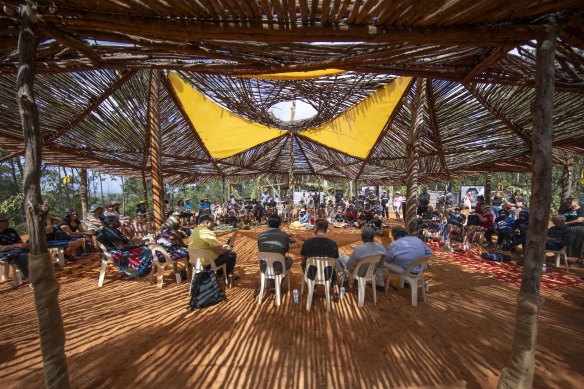
Partake in Indigenous workshops and cultural walks.Credit: Peter Eve
The Prime Minister might attend again this year, perhaps stand in the queue for barista coffee with long-time Garma ambassador and actor Jack Thompson, or musician Paul Kelly. Ignorance won’t stand a chance where goodwill is entwined so effortlessly through activities shared: cultural walks; weaving workshops; live performances by some of the biggest names in Indigenous music.
Take a pathway through the bush to the Gapan Gallery, an outpost of the respected Yirrkala Art Centre, to find limited edition prints and etchings hanging in a serene grove. When dusk descends like a velvet curtain, there are lessons on Yolngu astronomy, so many stories in the nocturnal sky where constellations validate culture and community, tell how to live and how things came to be.
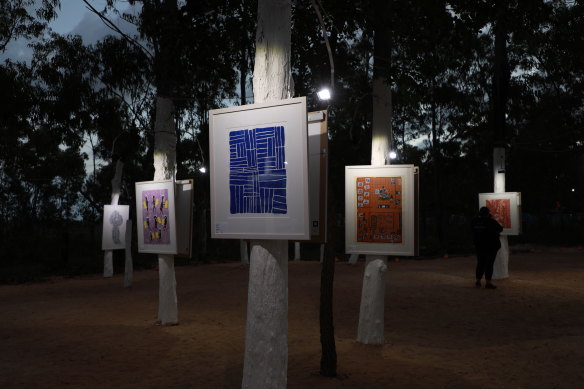
Take a pathway through the bush to the Gapan Gallery.Credit: Jeanie Govan
There is little chance of solitude in this all-encompassing cosmological place of art (miny’tji), dance (bunggul), song (manikay) and performance (gakal) but, always, a sense of timelessness. Time in which to ponder the shared beauty of a culture that continues to flourish in the gaze of the ancestral crocodile at the edge of the Arafura Sea.
THE DETAILS
VISIT
The Garma Festival is Australia’s largest Indigenous gathering, a four-day celebration of Yolngu life and culture held in remote north-east Arnhem Land from August 2-5. Hosted by the Yothu Yindi Foundation, under festival director Joel Ulbricht, Garma will showcase traditional miny’tji (art), manikay (song), bunggul (dance) and story-telling, as an important meeting point for the clans and families of the region.
A General Admission ticket is $2970 and $5200 for a corporate pass (usually groups of 10). Yolngu attend for free and other Arnhem Land residents can also buy discounted tickets to ensure it remains an accessible event for the local community.
STAY
You must complete a registration of interest and be accepted to attend. Garma tickets are inclusive of tent accommodation and meals and a permit is required from the Northern Land Council.
FLY
It’s a 45-minute flight from Darwin to Gove and a 20-minute bus ride to the Gulkula site for the Garma Festival.
MORE
The writer was a guest of Tourism NT.
Sign up for the Traveller Deals newsletter
Get exclusive travel deals delivered straight to your inbox. Sign up now.